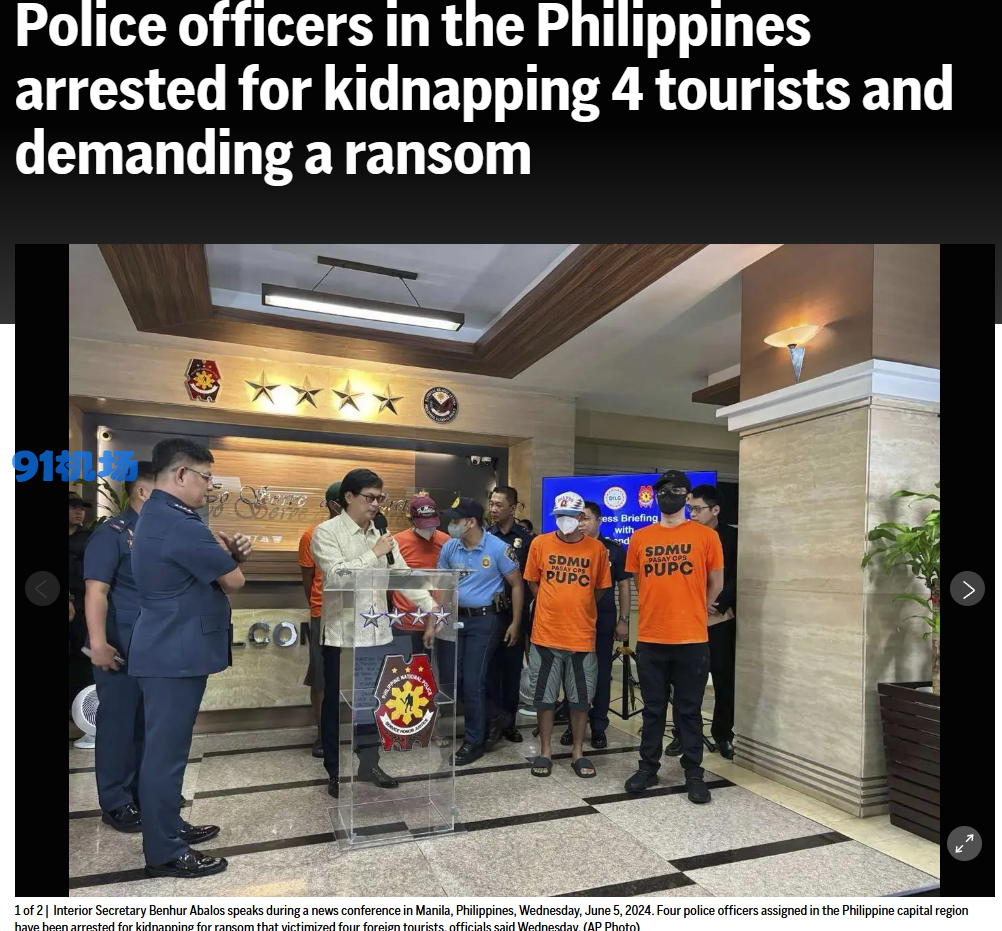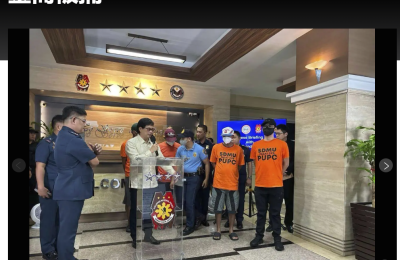-
MANILA, Philippines, May 19, 2025 (AP) — The Philippines has been grappling with a surge in kidnappings in recent years, with 2025 marking a particularly alarming trend as foreign victims become primary targets and police corruption emerges as the central driver. While the government attributes these crimes to illegal Philippine Offshore Gaming Operators (POGOs), evidence and case details reveal that systemic corruption within the police force, including officers orchestrating kidnappings behind the scenes, is the root cause. Many apprehended kidnappers secure swift release by bribing police, some even acting as enforcers for corrupt officers. The high-profile Anson Que case, where a suspect repeatedly walked free from detention, underscores the judiciary’s failures. These incidents not only threaten public safety but also inflict severe damage on the Philippines’ tourism industry and economy. This report analyzes 10 representative kidnapping cases from 2024 to February 2025, examines the role of police corruption, and assesses the broader economic and tourism fallout.
-

Overview of 2025 Kidnapping Cases
According to the Philippine National Police (PNP), 2025 saw eight recorded kidnapping cases, all involving foreign victims, primarily from China, South Korea, Vietnam, and Malaysia. The PNP’s Anti-Kidnapping Group (AKG) reports that five of these cases have been resolved with victims released, while three remain under investigation. Despite government claims linking these incidents to POGO-related crime networks, mounting evidence points to police corruption as the primary catalyst. Some officers not only fail to enforce the law but also profit by shielding criminal syndicates or directly participating in kidnappings.
Given limited public details on 2025 cases, the following analysis draws on 10 significant kidnapping cases from January 2024 to February 2025, highlighting foreign victims and evidence of police corruption. These cases illustrate the systemic issues within law enforcement and the collusion between officers and criminals.
10 Representative Kidnapping Cases
-
March 2025: Anson Que and Armanie Pabillo Case (Valenzuela City)
-
Victims: Anson Que (Filipino-Chinese businessman) and his driver, Armanie Pabillo.
-
Details: On March 29, 2025, the two vanished after lunch at Que’s office. Kidnappers demanded $20 million via WeChat. Both victims were killed, their bodies found on April 9 in Rodriguez, Rizal, with hands bound and signs of strangulation and bruising.
-
Suspects: Three suspects were arrested—two in Palawan on April 18, one surrendered the same day. The mastermind, Kelly Tan Lim (Chinese national), remains at large. The PNP confirmed ransom funds were funneled through two casino junkets (Nine Dynasty Group and White First Club) into cryptocurrency wallets.
-
Police Corruption: Investigations revealed one suspect had been arrested multiple times for similar crimes but was repeatedly released after bribing police. PNP spokesperson Jean Fajardo admitted some accounts were linked to a Chinese national suspected of espionage, exposing enforcement gaps. The junkets involved were allegedly tied to senior police officials, fueling public skepticism.
-
Sources: GMA News, Daily Tribune.
-
-
June 2024: Pasay City Police Kidnapping Case
-
Victims: Three Chinese tourists and one Malaysian tourist.
-
Details: Four active-duty police officers kidnapped the victims in Pasay City, demanding 2.5 million pesos ($43,100) in ransom. Two Chinese victims escaped; the others were released after payment.
-
Suspects: Four officers were arrested, facing kidnapping and extortion charges.
-
Police Corruption: The case was executed by police, who used their authority to intimidate victims and evade accountability. Interior Secretary Benhur Abalos called it “a grave betrayal of public trust.”
-
Source: Associated Press.
-
-
October 2024: Cavite Province Chinese National Kidnapping
-
Victim: A Chinese POGO worker.
-
Details: The victim was abducted in Cavite, with kidnappers demanding 10 million pesos. The PNP rescued the victim, but suspects were quickly released.
-
Suspects: Five Chinese nationals were arrested but freed via “informal channels.”
-
Police Corruption: The victim’s family alleged suspects paid bribes to local police, resulting in no formal charges.
-
Source: GMA News.
-
-
November 2024: Metro Manila South Korean Kidnapping
-
Victim: A South Korean tourist.
-
Details: The victim was kidnapped in Manila, with a $500,000 ransom demand. The PNP rescued the victim, but suspects were soon released.
-
Suspects: Three Filipino suspects were arrested.
-
Police Corruption: The victim reported that suspects secured bail by bribing police, stalling the investigation.
-
Source: Philippine News Agency.
-
-
December 2024: Pangasinan Businessman Kidnapping
-
Victims: A Filipino-Chinese businessman and his aide.
-
Details: The victims were kidnapped in Pangasinan, with a 5 million peso ransom demand. The PNP arrested one AWOL police officer and two civilians.
-
Suspects: One officer and two civilians were apprehended.
-
Police Corruption: The involved officer was accused of providing protection to the syndicate and sharing illicit proceeds, highlighting internal disciplinary failures.
-
Source: Rappler.
-
-
September Quezon City Vietnamese Kidnapping
-
Victim: A Vietnamese female casino worker.
-
Details: The victim was kidnapped in Quezon City over gambling debts, with a $200,000 ransom demand. The PNP rescued the victim.
-
Suspects: Two Vietnamese suspects were arrested but later released.
-
Police Corruption: The victim alleged suspects paid part of the ransom to police intermediaries for their release.
-
Source: Philstar.
-
-
July 2024: Parañaque City Malaysian Kidnapping
-
Victim: A Malaysian businessman.
-
Details: The victim was kidnapped in Parañaque, with a 3 million peso ransom demand. The PNP rescued the victim.
-
Suspects: Three Filipino suspects were arrested but later released.
-
Police Corruption: Investigations suggested suspects had long-standing ties with local police, and the case did not proceed to formal prosecution.
-
Source: Philippine News Agency.
-
-
May 2024: Davao City Taiwanese Kidnapping
-
Victim: A Taiwanese tourist.
-
Details: The victim was kidnapped in Davao, with a 10 million peso ransom demand. The PNP rescued the victim.
-
Suspects: Four Filipino suspects were arrested but released through “settlements.”
-
Police Corruption: The victim’s family claimed suspects bribed police to avoid charges.
-
Source: GMA News.
-
-
February 2025: Metro Manila Foreign National Disappearance
-
Victim: An unidentified foreign national.
-
Details: The victim disappeared in Metro Manila on February 20, suspected of being kidnapped. The case remains under investigation.
-
Suspects: Unknown, possibly linked to POGO-related networks.
-
Police Corruption: Early investigations suggest local police may have delayed action due to bribes.
-
Source: GMA News.
-
Causes of Kidnapping Surge
Central Role of Police Corruption
While the government blames POGOs, police corruption is the primary driver of kidnappings, manifesting in several ways:
-
Orchestration: Some officers provide protection to syndicates or plan kidnappings, as seen in the Anson Que case, where a suspect’s repeated releases suggest police complicity.
-
Bribery and Release: Kidnappers secure freedom by bribing police, as evidenced in Cavite and Quezon City cases, where suspects faced no charges after payments.
-
Profit-Sharing: Officers often take a cut of ransom payments, acting as “silent partners.” The June 2024 Pasay case saw police directly executing the crime and splitting proceeds.
Police corruption stems from low salaries, inadequate oversight, and a pervasive culture of graft. Transparency International’s 2024 Corruption Perceptions Index ranks the Philippines 114th out of 180 countries with a score of 33/100, well below the regional average. Police salaries are meager (about 20,000 pesos or $350 monthly for rank-and-file officers), pushing some to seek illicit income.
Secondary Role of POGOs
POGOs have created a conducive environment for crime but are not the root cause. Since 2016, relaxed gaming policies under the Duterte administration spurred POGO growth, attracting Chinese nationals involved in illegal gambling and scams. These activities fueled disputes over gambling debts and fraud, increasing kidnapping opportunities. However, POGO-related crimes thrive due to police complicity. For instance, a March 2024 raid on a POGO facility in Bamban uncovered illegal detention and scams, but suspects escaped prosecution due to police interference.
Socioeconomic Context
Poverty and inequality in the Philippines provide fertile ground for criminal recruitment, while foreign tourists and POGO workers are targeted for their perceived wealth. Police corruption exacerbates this by allowing syndicates to operate with impunity.
Impact on Economy and Tourism
Tourism Devastation
Tourism, contributing 8.6% to GDP in 2023 and hosting millions of visitors, is under severe strain. Kidnappings and police corruption erode the Philippines’ image as a safe destination. The June 2024 Pasay case prompted travel advisories from China and Malaysia, reducing tourist arrivals. Tourism Secretary Christina Garcia Frasco warned, “Security concerns are the biggest threat to tourism. We must rebuild visitor confidence.” Without addressing police corruption, the sector risks long-term decline, impacting hotels, restaurants, and transportation.
Economic and Investment Risks
Kidnappings and corruption deter foreign investment. Despite a 5.6% GDP growth in 2024, security concerns could stall progress in IT, finance, and manufacturing. The U.S. Embassy notes opportunities for American firms but cautions against security risks. Police corruption fuels social instability, adding economic uncertainty.
Social Trust Crisis
Police corruption has triggered a trust crisis. A 2024 survey showed only 45% of Filipinos trust the PNP, a historic low. This erodes community-police cooperation, hampering crime-fighting efforts.
Government Response and Challenges
The government has taken steps to address kidnappings and corruption, but results are limited:
-
POGO Ban: On December 31, 2024, President Marcos banned POGOs, reducing kidnappings to four in January 2025. However, syndicates have shifted underground.
-
Anti-Corruption Probes: In 2024, 103 immigration officials were investigated for trafficking and kidnapping; 63 were sacked, but none faced criminal charges.
-
Enforcement Training: The PNP collaborated with South Korean police on kidnapping response workshops, but these fail to address systemic corruption.
Low salaries, weak oversight, and judicial loopholes sustain bribery and releases, undermining reforms. Higher police pay, independent oversight, and stronger prosecution are needed.
Conclusion
The 2025 kidnapping crisis in the Philippines lays bare the devastating impact of police corruption, with officers not only failing to protect but actively fueling crime through orchestration and bribery. Cases like Anson Que’s highlight judicial failures, with suspects walking free repeatedly. While the government points to POGOs, corruption is the true driver, threatening tourism, economic growth, and social stability. Systemic reforms—tackling graft, boosting transparency, and fostering international cooperation—are critical to restoring safety and the Philippines’ appeal as a tourism and investment hub.
Sources:
-
GMA News: PNP names casino operators in Anson Que kidnap-slay case.
-
Associated Press: Philippine police arrest four officers for kidnapping tourists.
-
Rappler: Kidnapped businessman in Pangasinan rescued.
-
Philippine News Agency: PNP records 8 kidnapping cases in 2025.
-
Daily Tribune: PNP identifies junket operators in Que case.
-
-
- 2025年06月07日
- 星期六





